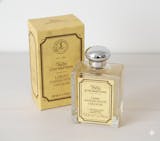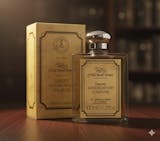Shaving Soap or Shaving Cream?

If you are on the perpetual quest for the best shave of your life, you are not alone. Wet shaving can often feel like an enigma, a code so unbreakable even Alan Turing couldn't crack it. Shaving cream vs shaving soap, the blue pill or the red pill, down the rabbit hole we must go.
Which one is the clear defining leader that delivers a smoother and closer shave, the most luxurious cushiony lather, so thick and so creamy you could frost a wedding cake with it? Ask two experienced wet shavers and you are bound to get three separate opinions on which is best.
Even the best shaving products, the sharpest of blades, the highest quality safety razor or straight razor, and a sublime fine badger brush alone are only part of the equation to a good shave.
Truth be told, as a traditionalist, through my exploration of the resulting lather of higher quality shaving creams and soaps, my personal kit will always contain a high-quality shaving soap that comes as a puck (triple milled soaps), glycerin based that retains water very well, a ceramic shaving bowl, a stiff shaving brush, and aftershave balm that is my preference.
Aside from canned shave cream or shape-shifting gel, higher-quality shave creams and soaps both produce a creamy lather that is both luxurious and delivers a smooth and gentle shave. No more cans, please. Let's be mindful of the environment.
But we aren't here for just a good lather or just a nice lather, we are on the quest for that luxurious lather thick as clouds, blocking out the sun with the consistency of a soft pillow, dense, smooth as silk, slick as the frost, the highest quality shaving experience of your life!
- Shaving Soap Vs. Cream
- The Story Behind the Debate
- What are Shaving Soaps?
- What are Shaving Creams?
- A Brief Mention of Shaving Gels and Foam
- Which is Better, Shave Cream Vs. Soap: The Verdict
- Lathering 101: How to Lather with Shaving Soaps and Creams
- The Ultimate Shave-Down: Shaving Soap Vs. Shaving Cream FAQ
Shaving Soap Vs. Cream
Ah, yes. We have come full circle. The answer is both complex and yet straightforward; it depends. Both produce great lather and offer a close shave; neither is definitively better than the other. The two serve their purpose.
It depends on:
- Your preference
- Your skin type (dry, oily, or sensitive)
- What base do you prefer (tallow-based (animal) or vegan)
- The fragrance profile (or lack thereof)
- The ingredients used (synthetic, natural, or mystical)
The best shaving cream or soap is a matter of what works best for you.
Therein lies the conundrum of every wet shaver, from the beginner to the experienced, when shopping for shaving products: which one offers the best shave? Let us solve the enigma by breaking down the anatomy of both, gaining a better understanding of the two, and finally ending the debate to answer the question of whether it is better to shave with soap or shaving cream.
The Story Behind the Debate
Pitting these two shaving lubricants against each other is a tradition that goes back to 1919, when Frank Shields, a former MIT professor, developed the first-ever canned cream Barbasol, the first canned shaving cream solution or alternative to using a shaving brush to work lather from soap.
It was the first real progress in the shaving process since the Mesopotamians mixed animal fats with ash to create primitive soaps thousands of years ago, similar to the ancient Egyptians, who were the first in history to take shaving seriously.
This new cream eliminated the need for a shaving brush, providing faster shaves but also tinkering with the format of this ancient ritual. And some people didn't appreciate that, which we understand because shaving is personal.
Soap traditionalists had an opinion about this newfangled cream, and they did not like it. Too thin, too perfumed, too messy. They preferred the shave they got from soap. But Shields' cream did garner a fair amount of fans, especially those looking for convenience, and thus canned cream became more popular.
But that doesn't necessarily mean they're better. Thus was born the eternal question all men who wet shave must ask...
Shaving Soap or Shaving Cream: Which is Better?
There is an answer, one is better than the other, but we'll be straight with you right away: the winner of this exchange of views depends on your needs and preferences.
Sorry, we know that sounds like a cop-out. Unfortunately, there's no way around it. The answer really does hang in the balance of your personal preference.
So let's nerd out on this! Let's get smart about what will work best for you and crack open the books. Set aside a few stinkin' minutes of your life and get an answer that makes you happy about your shave! If you're new to wet shaving, it's a requirement. But don't worry—it will be fun.
What are Shaving Soaps?
 Shaving soap offers a firmer, more traditional lathering experience compared to easy-to-lather creams.
Shaving soap offers a firmer, more traditional lathering experience compared to easy-to-lather creams.
Shaving soaps were introduced in the late 14th century and were the only option for shaving men until World War I. Shaving soap is the classic choice for traditional shaving, designed to provide a protective barrier between your skin and a shaving instrument, such as a straight razor or DE safety razor, which offers less irritation when shaving and reduces razor bumps.
Shaving soaps get their texture from glycerin, which is a fancy term for fat or oil (tallow-based soaps) that has a high water content that provides the perfect thick lather. Glycerin-based soaps can be both vegan and non-vegan, composed of tallow, often combined with perfumes and intense fragrances, or available fragrance-free.
The options are limitless, from contemporary purveyors to artisanal, such as Barrister and Mann from the United States, or Classic Italian shaving soaps, such as Cella, or luxury shaving soaps from Thiers Issard of France, to the generational Taylor of Old Bond Street of England, which makes discovering and shaving with shaving soaps oh so fun.
Every person, regardless of their gender or identity, can shave with shaving soap. If you love traditional shaving, you've got to love shaving soap. You can like both, either shaving cream or shaving soap, but for a true classic shave, it will always be with traditional shaving soaps.
Then the question becomes, is there a difference between my shaving soap and the Irish Spring you see in the supermarket?
Answer: Yes.
Shaving soap is made with ingredients that lubricate, hydrate, and sterilize your skin. Soap is made to wash the day away. Perfect for prepping your face for a shave, but not too strong for scrubbing other parts of your body.
Sounds simple, right? Shaving soaps are used for shaving. But there's more.
There are a few different types of shaving soaps, which can get confusing. For instance, there are creamy soaps, and later we'll see creams, but they're not the same thing.
Shaving Soaps Types
- Triple-milled soaps
- Cream soaps
- Semi-hard soap
Regardless of its namesake, shaving soaps aren't soaps. Soaps are dehydrating and formulated to remove dirt and grime. In contrast, shaving soap is formulated to do the opposite: hydrate and moisturize, disinfect, add effortless glide, and, of course, offer a thicker lather.
To understand what shaving soap is, we must first understand the manufacturing process behind it. Shaving soap can be triple-milled, which indicates that the soap was first grated, then melted, and finally pressed into a shape that we call a "puck".
This process evaporates the extra moisture from the soap, yielding a milder, longer-lasting, and generally superior product that requires a shaving brush to lather, and is the most popular in our online shaving store.
Then there is "croap soap," a combination of cream and soap, which shares the same qualities as shaving creams and soaps, such as The Goodfellas' Smile Sea Citrus Shaving Soap. Due to the amount of moisture they contain, croaps do not require a brush to render lather.
The third categorization is semi-hard soap, which is a hybrid between triple-milled and croap soap or cream soaps. More solid than soft shaving cream and has plenty of stable, creamy bubbles. The texture of this semi-hard soap is harder than many shaving creams and softer than soaps, but it can still have the shape of a puck and doesn't last long.
Ingredients
The truth of the matter is that no matter which you choose, shaving soap or cream, you always have to read the ingredient list. Here's the key to understanding what it all means:
- Understand your preferred balance of ingredients
- Find a maker that gives you the best combination of the most beneficial parts
Okay, so that takes a fair amount of care, and we think it's worth it, but even if you don't, knowing what you're looking at can at least help figure out what to do if you decide you want a change in the future.
Traditional Shaving Soap
Thank the ancient Sumerians over 5,000 years ago for the first soap recipe: oil and ash. Not much has changed. To make shaving soap, oils and fats are boiled with alkalis (sodium or potassium hydroxides). The best shaving soap hasn't strayed much from this formula.
There are plant and animal-fat-based soaps. Here are some of the most common:
- Coconut oil
- Palm oil
- Tallow (animal fat)
Soaps also contain ingredients with high stearic acid, which help make it slick and to lather up. When mixed with the fats, it creates a "saponifying" effect, which, as this amazing word suggests, is the act of something turning into soap.
Because soaps can be drying, the best manufacturers add moisturizing agents. Look for:
- Oils like jojoba oil, safflower oil, argan oil, and avocado oil
- Butters and milks, like cocoa butter, kokum butter, goat’s milk, mango seed butter
- Other ingredients like allantoin, aloe vera, beeswax, or lanolin
All of the above elements work in concert to disinfect and nourish the skin. Vitamin E (tocopherol) is a protective agent that also fights free radicals. Menthol cools the skin but also serves as an antiseptic.
One last word: creamy shaving soaps acquire their smooth texture with glycerin (fat or oil).
Different Forms of Shaving Soaps
All things considered, here are the various forms of shave soap available.
Shaving Stick
A shaving stick is a type of shaving soap that comes in a cylindrical or stick form, allowing for direct application to wet skin, lathering in your hand, or use on a brush, either hand-lathered or brush-lathered in a bowl. It's also great for touch-ups while wet shaving, allowing you to apply more soap where needed easily. Good for travel and quick shaves.
Who would use a shaving stick?
- Shaving sticks are compact and take up less counter space. They are great for stuffing into a dopp kit for traveling, weekend getaways in a toiletry bag, or for anyone who has limited storage space or counter space.
Shaving Soap Bars
If you can remember a time before disposable razors and close your eyes and think of a wet brush, a safety razor, and lather dressing the bathroom sink, or a barber lathering warm water in a shaving bowl, you will be transported back to a time of traditional shaving. The kind your grandfather used to do, that's shaving bar soap.
Originally produced for men's beards to soften a beard before straight razor shaving or with a classic double-edge safety razor, shaving soaps are the most preferred choice among wet shaving aficionados.
Shaving soap bars are hard soap that is triple milled in the shape of a "puck", traditionally triple pressed into a solid consistency with an indentation for direct wet lathering with a brush by hand in a shaving bowl that provides some would say a superior creamy thick lather and protective barrier between the skin and the shaving instrument.
Who would use shaving soaps?
- Shaving soap has seen a great resurgence in popularity and is readily available to purchase online. If you hold your daily shaving ritual in high esteem and savor the traditional aspects of the wet shaving routine, value having a bit more control over one of the most essential products used in your shaving regimen, then shaving soaps are the preferred choice.
Shaving soaps are long-lasting, the most economical choice, and no more complicated than off-the-shelf shaving gels or creams, and let us not forget the perfect lather.
Creamy Shaving Soaps
Soft shaving soaps that have a smooth, moist texture and soft consistency. A great example of creamy shaving soaps (morbido shaving soaps) is The Goodfellas' Smile, which offers equally excellent results. The only difference is the water content, which is why you need to purchase them more frequently compared to triple-pressed soap pucks.
Who would use creamy shaving soaps?
- The performance of hard shave soaps is comparable to that of other soaps, regardless of skin type, in terms of shaveability and protection against razor burn and skin irritation. The only difference is economics. Creamy soaps don't last as long; although they're more luxurious, they don't fit the economical bracket if that is a concern.
What are Shaving Creams?
 Shaving creams like D.R. Harris & Co. are a classic choice for a smooth, comfortable wet shave.
Shaving creams like D.R. Harris & Co. are a classic choice for a smooth, comfortable wet shave.
Photo by Jake Eastham and D.R. Harris
Shaving creams are incredibly well-known in the shaving community. Who hasn't heard of D.R. Harris & Co. shaving creams? Shaving creams soften your skin and hair in preparation for wet shaving, but they carry more moisture than shave soap. They are easier to work into a lather than soap and work on many different kinds of stubble and skin types.
Types of Shaving Creams
- Latherless Shaving Creams: Can be applied directly to wet skin without having to work into a lather.
- Lathering Shaving Creams: Add water to the cream, then work it into a lather on your skin, in your hand, or in a bowl.
Ingredients
Not all shaving creams are made with the exact same things, but they are all made the same way. The ingredients have a dual action, cleaning dirt and grease and softening the skin.
Lathering and cleaning agents:
- Stearic acid
- Triethanolamine
Emulsifiers (hold onto the skin):
- Lanolin
- Polyoxyethylene sorbitan monostearate emulsifiers
Emollient or skin softener:
- Glycerin
- Water
A Brief Mention of Shaving Gels and Foam
 Aerosol gels and foams may be convenient, but they can’t match the quality of a true shaving soap or cream.
Aerosol gels and foams may be convenient, but they can’t match the quality of a true shaving soap or cream.
Photo by KITREEL on Depositphotos
Innovation may breed ingenuity, but it can't guarantee taste. Thus, aerosol shaving gels and foams—solutions that work in a pinch still create foam but provide an otherwise terrible wet shaving experience. A long time ago, marketers labeled them as creams, but don't get them confused. If you push a button to make something transform its shape and nature, or it lights on fire, it is not true shaving cream.
Here we talk about shaving creams in the traditional sense, made with fine, natural, non-combustible ingredients.
The Relationship Between Soap and Brushes
You can make a tough face all you want. Facial skin is still amongst the most sensitive skin on the body. Shaving brushes are designed to prepare your face for the up close and personal experience with a razor blade. Even the best shaving soap requires a brush. You can use a stiff brush or a soft brush, just not a no-brush.
The bristles of a shaving brush are malleable and firm. Pushed into your skin, they help your pores open up and prepare you for the razor's relative harshness.
It's easy to dismiss a brush as excessive pageantry, but they're fully functional and serve as the secret weapon for many wet shavers.
Here are a few tips:
- Use stiffer and harder brushes with hard soaps
- Use a softer brush for creamier soaps
- A badger bristle brush is higher quality than synthetic, but you can find good versions of both
Shaving brushes are so important to shaving; we wrote about them, too! If you already have one, we have a complete guide on cleaning your shaving brush.
Which is Better, Shave Cream Vs Soap: The Verdict
As you can see, it really does depend.
Both shaving creams and shaving soap have their advantages and disadvantages. Some say creams are easier to lather, but shaving soaps cost less to buy. Creamy lathers are too thin, say some; soapy lathers are too thick, say others. Use creams in the home, soaps on the road, says the man about town. Use soaps or creams, just don't use shaving gel, says the guy who's tried it all.
It all depends on what you need.
-
Complete Control
For a premium shaving experience, both a good quality shaving soap and a shaving cream can be great.
-
Durability
Hard shaving soap is the most durable of all shaving lubricants.
-
Comfortable shave
This really depends on the ingredients. Glycerin soaps provide moisture and lead to an irritation-free shave.
-
Time
Shaving cream requires fewer steps, but are you really saving that much time?
-
Travel
Sticks are great for travel. Toss them in your bag and go.
-
Scent
Since your cream or soap determines how you'll smell up close, make sure to follow your nose, too.
So, Which is It? Cream or Soap?
Why pick? Can't you enjoy both? Shouldn't you be able to enjoy a soap when you want a more traditional experience and cream when you want something a little different? Why can't you have a stick for on the road and a tube for in the house?
You can, fellow wet shavers, you can! Start off with a few different products, and eventually you'll find one you will love.
Lathering 101: How to Lather with Shaving Soaps and Creams
 Learn how to whip up a rich lather like a pro—whether you’re team soap or team cream.
Learn how to whip up a rich lather like a pro—whether you’re team soap or team cream.
Photo by Photo By: Kaboompics.com on Pexels
How to Lather with a Shaving Soap
Shaving soap requires a little skill. This scares some guys off, but they weren't cut out for shaving anyway.
With a bowl
- Thoroughly dampen and saturate your shaving brush with warm water.
- Circle the tip of the brush around the soap until the soap has filled the brush with bubbles. Add moisture to the brush if needed.
- Dab the bubbles into a bowl or your hand.
- Place your brush back in the lather.
- Move in small circles as the bubbles reduce and work into a creamy, rich lather.
- At your desired thickness, apply it to your face with the brush.
You can make enough lather for your whole shave at once, or you can lather up as you go.
Directly on the tin
- Soak your shaving brush in warm water for 5–10 minutes to soften the bristles.
- Gently shake or squeeze the brush to remove dripping water—it should be damp, not soaking.
- Swirl the damp brush directly on the soap in the tin until the tips are coated and begin to form a light foam.
- Create the lather right on your face by swirling the brush in small circles until a creamy layer forms.
Tip: Add a few drops of water to the brush if the lather feels too dry.
How to Lather with a Shaving Cream
Shaving cream was born out of convenience, but it can be as easy or involved as you want it to be. Just be sure you're using a good quality shaving cream.
With a brush
- Add about a quarter-sized dollop of shaving cream to the brush.
- Add about 20 drops of water to the bottom of the bowl.
- Begin mixing in a circular motion, adding pressure in intervals until you have a good, dense cream.
- Add water as needed.
Without a bowl
- Apply the same amount of cream as with a brush.
- Wet your face.
- Lather in circular motions on your face until it is a fully creamy texture.
- Add water as needed by dipping in a bowl or quickly running it under the faucet.
Without a brush
- Wet your face.
- Apply cream evenly to hands.
- Pat in a circular motion on your skin.
- Add water in small amounts to your hands.
The Ultimate Shave-Down: Shaving Soap Vs. Shaving Cream FAQ
Welcome to the slick and smooth world of shaving! Got questions about whether to slap on some soap or cream before taming that mane? Dive into our bubbly FAQ where we slice through the froth to bring you the best shave advice!
Q1: What's the real scoop between shaving soap and cream?
A1: Ah, the eternal debate! Shaving soaps are the traditionalists of the shaving world—hard pucks of concentrated goodness that whip up into a rich lather with a bit of elbow grease and a good brush. Shaving creams, on the other hand, are the easy-going type, softer and creamier, ready to lather up faster and with less fuss.
Q2: Is there a winner in the lather longevity league?
A2: If endurance is your game, shaving soap might just be your MVP. It takes a bit longer to get going, but once you've got that lather locked in, it tends to hold moisture and stay frothy longer than its cream counterpart, making it perfect for those who take their sweet time shaving.
Q3: I’m new to this. Should I start with soap or cream?
A3: Creams might just be your best bud if you're a rookie. They're forgiving, easy to use, and don’t require much technique to create a decent lather. Perfect for a quick and effective shave without the learning curve.
Q4: What about the cost? Which is more economical?
A4: Shaving soaps generally win the penny-pinching prize. They last longer since they’re more concentrated, giving you more shave for your buck. Creams might seem cheaper upfront, but you'll go through them quicker.
Q5: Any tips for using shaving soap like a pro?
A5: Grab your shaving brush and think like an artist. Start by swirling the brush over the soap to load it up. Then, in a separate bowl or your hand, work that brush in circles to build up a creamy lather. Remember, it's all in the wrist, and practice makes perfect.
Q6: Can you recommend a product to start with?
A6: Absolutely! For soaps, try classics like Barrister & Mann or Ariana & Evans shaving soaps.
They’re beloved in the shaving community for their quality and performance. If you're leaning towards creams, TOBS (Taylor of Old Bond Street) offers a variety of scents and superb quality that won’t disappoint.
So there you have it, folks! Whether you're team soap or team cream, it's all about finding that perfect shave that makes you feel sharp and fresh. Happy shaving!
*Updated: April 2024
More Related Articles
Guide to Using Shaving Soap for Lathering
How to Clean and Store a Shaving Brush
The Complete Guide to Shaving Brushes 2025






























Leave a comment